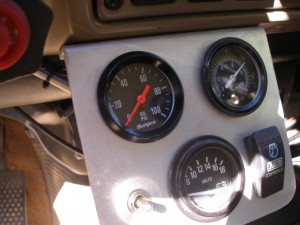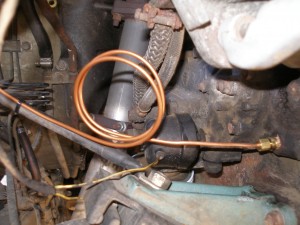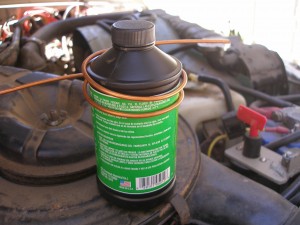By Tony K
 Some really low readings on the stock gauge in my BJ got me worried and made me wonder about the accuracy of the factory gauge. I had heard about the questionable nature of the stock gauge and this was reinforced by several mechanics that I work with. They all said you can’t trust the electronic oil gauge. My feeling is that most factory gauges are just idiot lights with arms… The only way to be sure about the pressure is to check it with a mechanical gauge. And what I found somewhat funny is that in the Factory Service Manual even Toyota says to hook up a mechanical gauge to find out what the pressure is.
Some really low readings on the stock gauge in my BJ got me worried and made me wonder about the accuracy of the factory gauge. I had heard about the questionable nature of the stock gauge and this was reinforced by several mechanics that I work with. They all said you can’t trust the electronic oil gauge. My feeling is that most factory gauges are just idiot lights with arms… The only way to be sure about the pressure is to check it with a mechanical gauge. And what I found somewhat funny is that in the Factory Service Manual even Toyota says to hook up a mechanical gauge to find out what the pressure is.
How bad is my stock gauge? Really bad, at idle when the rig is warm it sits on zero. Can’t get worse than that if you ask me. Time to hook up a mechanical gauge. And thankfully the mechanical gauge eased my fears of a meltdown, even when warm I had between 8 and 15psi. Just depended on how hot the oil was.
Just why do I want confirmation of the pressure? In the woods in the middle of nowhere when my rig is idling I want the peace of mind that my rig still has oil pressure. For me there was no better reason to visit my local auto parts store and pick up a mechanical oil pressure gauge. The one I got reads from 0-100 which is just right as cold starts can peg out the gauge at about 70psi. On the road it settles in around 30psi once it’s warm. And like I mentioned it’s pretty low at idle when warmed up but not any thing I can’t live with.
Picking a place to hook it up on the block was easy as I had an unused sensor on the side of the block. And even though the threads were 1/8 BSP (metric or better known as British Standard Pipe) an 1/8 NPT fitting fit just fine once I ran a die onto the threads to make them a little smaller. This way they threaded in several turns with a little locktite to seal the deal. No leaks so far.
 Just a couple of things about the new gauge that worried me. There was no way the line that came with it was long enough to reach from the block to where I mounted the gauge and the fact that it is made of plastic. Doesn’t help that it is close to the exhaust pipe either. Found some longer line for the gauge but it was still made of plastic but I used it anyway just to get the gauge up and running. Did find out that you have to be extremely careful when tightening down the plastic line so you don’t damage the tubing.
Just a couple of things about the new gauge that worried me. There was no way the line that came with it was long enough to reach from the block to where I mounted the gauge and the fact that it is made of plastic. Doesn’t help that it is close to the exhaust pipe either. Found some longer line for the gauge but it was still made of plastic but I used it anyway just to get the gauge up and running. Did find out that you have to be extremely careful when tightening down the plastic line so you don’t damage the tubing.
But I was looking around on Ih8mud one day and I found a few of the guys had swapped out the plastic for copper and didn’t have any problems with the much more rigid line. And I liked the fact I no longer had to worry about melting the line. And the copper was far more forgiving when you tighten things down, just about impossible to crush or damage the copper when you snug things up.
Found some brass compression fittings at the local hardware store and a chunk of 1/8 in copper tubing that had been on the shelf at work for ages so I was set on the hardware end of things. Bending and installing the copper line was way easier than I expected. I even added a couple of flex loops in the engine bay to help with vibration. Nothing  scientific about the loops just bent the line around a bottle of brake fluid I had in the back of the rig. And the loops also add some extra length should I ever need to repair the connection to the block.
scientific about the loops just bent the line around a bottle of brake fluid I had in the back of the rig. And the loops also add some extra length should I ever need to repair the connection to the block.
Now I don’t feel so bad when my stock gauge reads zero and no need to worry about melted lines either.

